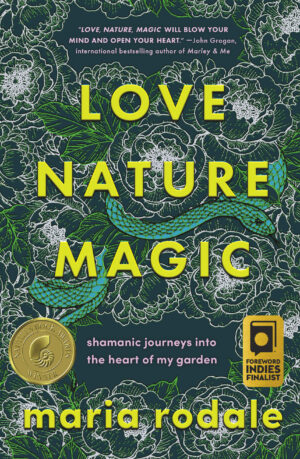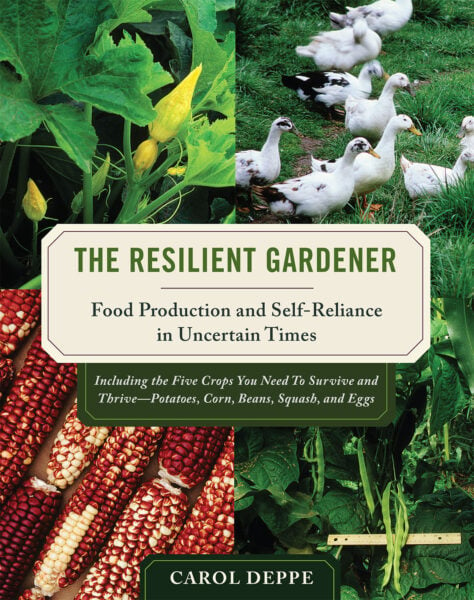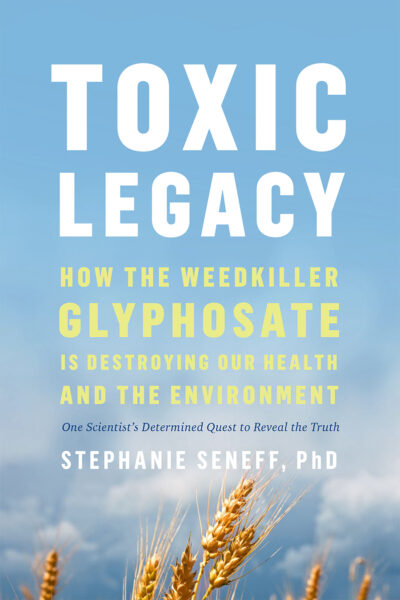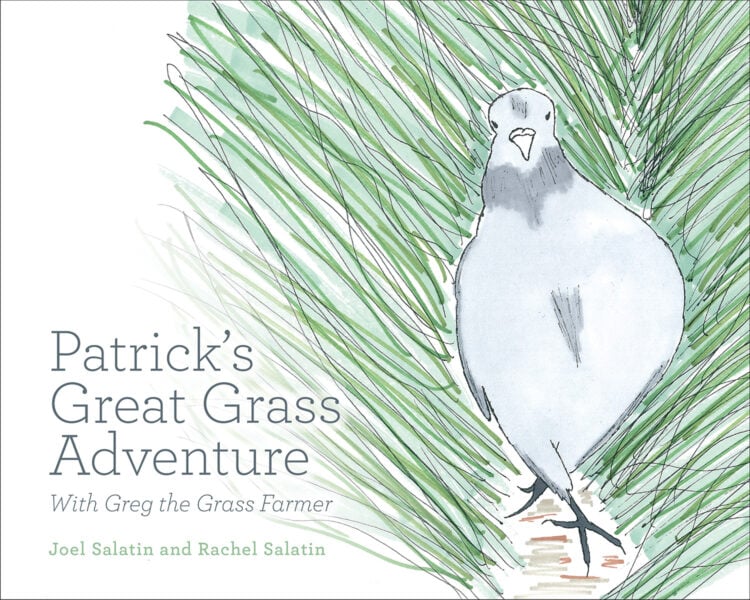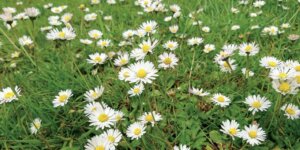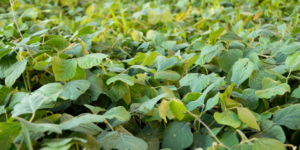Grass: Nothing Can Grow Without Love
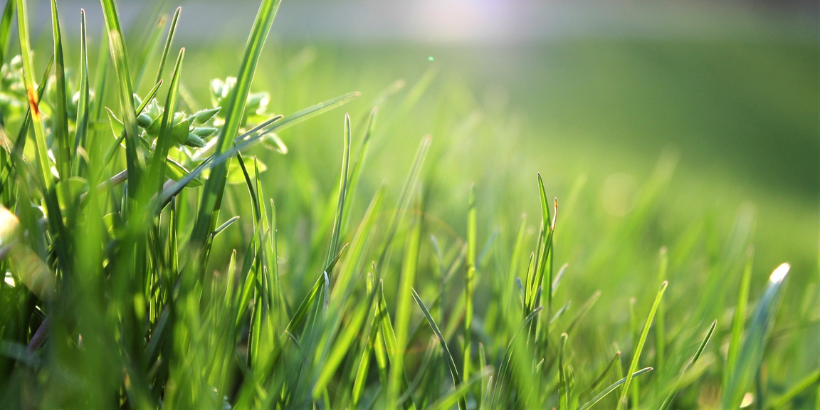
If you take a walk around your neighborhood in the spring and summertime, chances are you’ll catch someone mowing their lawn or treating their grass with chemicals. Homeowners around the country are fixated on ensuring that their lawn looks clean and maintained at all times — but the process of beautifying a lawn may just be destroying our grass and the environment it grows in.
To truly understand the perspective of grass, gardener and author Maria Rodale embarked on a unique Shamanic journey. In the passage below, she outlines her experience and the lessons she learned from each blade.
The following is an excerpt from Love, Nature, Magic by Maria Rodale. It has been adapted for the web.
The Basics of Grass: A Simple Yet Complicated Plant
Grass. Americans are obsessed with their grass.
I am not anti-grass. A nicely cut lawn is perfect for playing, walking barefoot, and getting from one place to the next. Some people I know and respect have love affairs with their lawn and even their lawn mowers and deeply enjoy the ritual of mowing. But some have taken lawn worship to the extreme. Conservatively speaking, lawn takes up more space in America than the top three agricultural crops combined. (That’s corn, wheat, and fruit trees.) Lawns also use a lot of water. Think about it for a minute…We devote precious water to a plant that we then mow, usually with gasoline-powered mowers, sometimes more than once a week. Not to mention all the toxic chemicals that people put on their lawns to get rid of “weeds,” especially the dreaded dandelion (her chapter is coming up next). What a waste. I call it the tyranny of tidiness.
Grass is not bad. In fact, I would vote for grass being good. Grass is a plant. It has roots. It transforms sunlight and carbon dioxide into energy and oxygen and stores the carbon in the ground…if it’s not sprayed with toxic herbicides, fungicides, and insecticides. Also, grass smells nice.
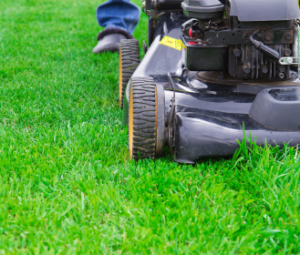 I have an acute sensitivity to toxic chemicals, whether they are agricultural chemicals, cleaning products, “beauty” products, or fake fragrances. I can’t wear makeup or use most beauty products because they make my eyes burn and itch. Chemical fumes make the skin between my upper lip and nose tingle painfully and turn blotchy red. I don’t go anywhere near the farm and garden chemical aisles in stores for this reason. Grass sets off my built-in toxin detector all the time. When I drive through a suburban neighborhood or past a golf course, I can feel the lawn chemicals—on my face!
I have an acute sensitivity to toxic chemicals, whether they are agricultural chemicals, cleaning products, “beauty” products, or fake fragrances. I can’t wear makeup or use most beauty products because they make my eyes burn and itch. Chemical fumes make the skin between my upper lip and nose tingle painfully and turn blotchy red. I don’t go anywhere near the farm and garden chemical aisles in stores for this reason. Grass sets off my built-in toxin detector all the time. When I drive through a suburban neighborhood or past a golf course, I can feel the lawn chemicals—on my face!
When my former husband, Lou, and I first divorced, we took turns living at our home with Lucia. During my times away, when I wasn’t traveling for work, I stayed at a cabin in the woods owned by the local conservancy. The previous tenant (OK, my mother) had relentlessly mowed the area around the cabin. I had no lawn mower, and no strong conviction to mow. Instead I let the grass grow. And that’s when the magic happened. The cabin started to feel like a mythical European fairy-tale cottage. Rather than becoming unruly, the grass took on the look of a woman with long hair blowing in the breeze. Abundant wildlife became even more prolific. Watching the fireflies blinking by the thousands in the long grass at dusk was a magical dream come true. I felt like I had healed the land. I also healed myself.
But who and what is grass, really? I wanted to learn more.
Understanding From the Root: Embarking On A Unique Journey
Did you know that the grasses we grow in our lawns are only a tiny fraction of the twelve thousand species of grasses found on planet Earth? The Poaceae (grass) family includes all the prairie grasses, grazing grasses for animals (which can be turned into hay once harvested), rice, wheat, and even corn and bamboo. Suffice it to say, we could not survive without grass. Animals eat grass. We eat grass. We eat the animals that eat grass. We don’t exist without grass. Grass is good. Very good.
I doubted that I could handle encountering twelve thousand species on a single journey, so I decided that I would talk with basic lawn grass. That’s still dozens of species, many of which are also considered weeds, such as crabgrass or Bermuda grass. But I was also eager to speak with and better understand an ornamental grass called sea oats, because it really annoyed the hell out of me.
When I first landscaped my yard, I wanted to include native plants. I consulted a landscaper I trusted and had worked with for decades. I had a vision of a whole area of native grasses that would be easy to maintain and would wave gracefully in the winds. He recommended sea oats.
It’s a pretty grass, although the seed heads now remind me of the brown marmorated stink bug (I planted the grass before that Asian species came to America). But within two years the sea oats was Out. Of. Control. Not only had it spread everywhere, but it was incredibly hard to dig up and get rid of. It has a knack for seeding itself in extremely difficult places—between rocks and nestled in the roots of my roses. Thus began Maria’s Glorious Five-Year Plan to eradicate sea oats from my garden. It has not gone well. It’s seventeen years later and sea oats are still everywhere.
Last year I went to a local native plant nursery to find some other grasses to plant in a different area. I asked the sales guy what to plant.
“Anything but sea oats,” I said. “It’s so invasive.”
“It’s not invasive because it’s native!” he protested.
“What is it then?” I challenged him.
“It’s aggressive,” he declared smugly.
Oh, so that’s the difference, I thought to myself as I rolled my eyes behind his back.
I decided to journey on a Monday morning. It was in December 2021, right after a giant tornado had destroyed areas in Kentucky and a few other states. So extreme weather was also on my mind.
The Journey Begins: A Conversation With Grass
I entered the journey by sliding down a mud chute. I landed in the grass. As I lay there, the grass consumed me and turned me into soil. Then I ceased to exist as a separate entity and felt completely absorbed into the earth. “We are hungry,” the grasses said. I went down underground and could hear a global network of communication happening in the roots. Meanwhile my eyes were burning painfully. I kept needing to rub them.
“We are the network of the world. And we communicate with the weather to act on our behalf, asking it to help us.” As Grass spoke, I could feel their hatred of humans for poisoning them. “Yes, plants can feel hate. We hate being poisoned. Hate it. And the weather feels our rage—hurricanes, tornadoes, droughts, floods, fires. When there is no love, there are no plants, no grasses. Without love, we recede, and all that’s left is the desert and man’s hubris.” I saw an image of a desert, completely devoid of life.
“We can’t grow without love. Nothing can grow without love.” I saw tornadoes, droughts, and destruction clearing the way so that plants could return to those landscapes without poisons. I understood that man himself can be like a toxic chemical if he overhunts and overgrazes, if he lives without love for the land, nature, and women. If he continues to spread poisons everywhere.
“What’s up with men and their lawns?” I asked Grass.
I saw an image of a woman being forced to dance until she collapsed from exhaustion and died. There was no joy in her dancing, just the frenzied panic of someone being forced to dance for someone else’s desires until there was nothing left of her.
“That’s not love, that’s pornography!” Grass said. “Men look at perfect grass and weed-free fields the same way they look at porn— like it’s some unblemished fantasy person they can do whatever they want to with, regardless of their desires and wishes. That’s not love, it’s porn! Men need to be taught how to love.”
“How can we teach men to love?” I asked.
“It starts with being raised with love and letting him feel safe to feel all his feelings. Letting his heart crack open so the grass can grow free. But then it’s about him learning to respect women and how to accept imperfection—in himself and others.”
I felt the time running out on my journey. So I quickly asked: “What about sea oats?”
“Get a grip, Maria. Relax. We are busy establishing the connections and growing where other stuff won’t.”
Grass continued, “All the grasses need love to grow. And yes, Earth is a woman, but the plants are male.” Then the journey ended.
Blade By Blade: Unpacking the Conversation
How to unpack this bizarre conversation with Grass? Eat breakfast, first. Then, let’s go line by line. Blade by blade.
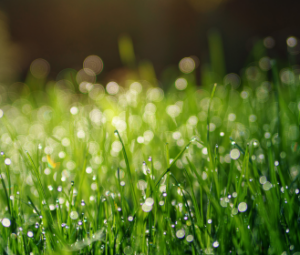 Blade 1: The grasses told me, “We are hungry.” And it’s true that grasses are a hungry species. This plant hunger is why chemical companies have put so much effort into coming up with synthetic chemicals to fertilize and manage grass crops. Yes, the same chemicals that are incredibly toxic to soil microbes and humans. The Rodale Institute Farming Systems Trial has shown that animal manures are the best fertilizer for corn (a grass), wheat (also a grass), and other grass crops, including pasture (more grass). Anyone who has had a lawn and a dog knows this is true—where the dog poops, a patch of greener grass grows. Same with animal poop in a pasture. This is why we need animals as part of our farming and feeding systems. People don’t like talking about poop, but it’s an essential resource that is free. Put the animals back on the grass and the poop on the crops and you don’t need synthetic fertilizers. Unfortunately, though, human poop has become toxic due to our overuse of pharmaceuticals, chemicals, heavy metals, cleaning supplies, and all the other stuff people flush down the toilet that they shouldn’t. This is why applying human sludge as fertilizer is rightfully not allowed on organic farm fields. (Do you know what else is a natural, super effective fertilizer for grass? Urine. Animal and human urine.) In addition to being hungry, grasses are very thirsty. I was happy to learn that the state of Nevada has banned “nonfunctional” grass in Las Vegas due to the extreme drought facing the region. (Although the ban exempts golf courses, homes, and parks and doesn’t take effect until 2026, which may be too late.)
Blade 1: The grasses told me, “We are hungry.” And it’s true that grasses are a hungry species. This plant hunger is why chemical companies have put so much effort into coming up with synthetic chemicals to fertilize and manage grass crops. Yes, the same chemicals that are incredibly toxic to soil microbes and humans. The Rodale Institute Farming Systems Trial has shown that animal manures are the best fertilizer for corn (a grass), wheat (also a grass), and other grass crops, including pasture (more grass). Anyone who has had a lawn and a dog knows this is true—where the dog poops, a patch of greener grass grows. Same with animal poop in a pasture. This is why we need animals as part of our farming and feeding systems. People don’t like talking about poop, but it’s an essential resource that is free. Put the animals back on the grass and the poop on the crops and you don’t need synthetic fertilizers. Unfortunately, though, human poop has become toxic due to our overuse of pharmaceuticals, chemicals, heavy metals, cleaning supplies, and all the other stuff people flush down the toilet that they shouldn’t. This is why applying human sludge as fertilizer is rightfully not allowed on organic farm fields. (Do you know what else is a natural, super effective fertilizer for grass? Urine. Animal and human urine.) In addition to being hungry, grasses are very thirsty. I was happy to learn that the state of Nevada has banned “nonfunctional” grass in Las Vegas due to the extreme drought facing the region. (Although the ban exempts golf courses, homes, and parks and doesn’t take effect until 2026, which may be too late.)
Blade 2: Grass said that grasses are the communication network of the world and they communicate with the weather. That’s interesting, and to me, it makes sense. There is some scientific basis to the concept that plants and the weather are connected and communicate with one another. There is evidence that trees and their roots communicate with one other. Why not grass? When trees are planted where there were none before, they lower the temperature, increase the amount of rain, and generally create a more pleasant place for humans and nature to thrive. This connection between grass, plants, and weather seems like an interesting area for more research to be done. Perhaps Las Vegas should plant more trees.
Blade 3: “When there is no love, there are no plants.” Looking back to the early history of life on Earth, there were plants before there were humans, so animal and plant love must count in this equation of no love = no plants. That’s interesting. If plants can feel hate, they can also feel love. There are amazing research studies demonstrating that plants emit screams when they are harvested and can warn each other when danger (insects or diseases) is nearby. If everything has feelings—plants, animals, and humans—yet we all need to eat, then it seems to me to best way to proceed is to harvest and eat whatever we decide to eat with reverence, kindness, and deep gratitude.
Blade 4: “That’s not love, that’s pornography,” said Grass, referring to the desire for a perfect lawn and to the woman forced to dance until death. I am not anti-porn. Porn can be a useful tool for learning and release. (But not child pornography, which is always horrifying and inexcusable.) Porn also can be an addiction. Equating the use of lawn chemicals and crop chemicals to pornography makes a lot of sense to me. Porn is not usually an expression of love. Nor is a perfect lawn or weed-free farm field an expression of love. It’s an act of voyeurism rather than connection. Treating grass with chemicals to force the lawn to grow in unnatural ways is also asking grass to “perform” without providing real food, or allowing the plants to rest when needed, or considering what their desires might be.
Real love considers the needs of the object of our love. Real love is interested in mutual pleasure. Real love is willing to embrace the messy imperfection of another person or place.
Blade 5: Studies supported by the National Institute of Justice show that most domestic violence and school shootings are perpetrated by people who experienced severe trauma and or a lack of love in childhood, whether from sexual abuse, parental abuse, or social bullying (or all three). We all need love to grow and be healthy. In fact, “failure to thrive” is a recognized medical term for children who don’t grow (physically, mentally, and emotionally), often (but not always) because they are denied love and care—specifically loving touch and emotional caring. Nothing can grow without love. To address the horrific gun violence in the United States (which is unparalleled in any other country), we must get to the root of the issue and have the true manly and womanly courage to protect each other and our children from harm. That’s what love does.
Blade 6: “Earth is a woman, but the plants are male,” Grass had told me. Now I get it. Life on Earth must be a partnership. One without the other is nothing. One with the other is everything. That is our work we need to do together—as men and women, as humans with nature. (That doesn’t mean that everything must be male/female heterosexual. As I have learned from researching this book, there is so much sexual diversity among all species that diversity isn’t just normal but perhaps it’s required for some reason we have yet to discover.) It dawns on me that when the beings I speak with say their work is about keeping nature in balance, they might also be asking us to do the same in terms of creating true partnership between the sexes. Among all the sexes and variations of sexes.
I am humbled by these journeys.
And scolded, too, as Grass told me to “get a grip” about sea oats. OK, I will relax. Although “get a grip” sounds an awful lot like weeding to me.
Lest you think I am naive to believe a world based on love can work when it comes to restoring nature, please read The Boy Who Grew a Forest, by Sophia Gholz. It’s not a long book—it’s written for children, but it’s a story that everyone should read. (Or you can look up the story online and see the boy, who is now a man, tell the story himself.) It is the true story of Jadav Payeng, who completely healed nearly 1,400 acres of barren land in India by planting bamboo (which is a grass) and nurturing and loving the plants that followed.
Nothing can grow without love.
People, we have work to do. But together we can do it.
Thank you, Grass.
Recommended Reads
Recent Articles
Everyone loves a refreshing, fermented, nutritious drink…even your garden! Take your fermentation skills out of the kitchen and into the garden by brewing fermented plant juice. The following is an excerpt from The Regenerative Grower’s Guide to Garden Amendments by Nigel Palmer. It has been adapted for the web. How to Make Fermented Plant Juice Fermented…
Read MoreWant to see your crops thrive this upcoming growing season? The key is in soil fertility and health. Spend time maintaining your soil’s health to guarantee bigger and better crops come harvest time! The following is an excerpt from No-Till Intensive Vegetable Culture by Bryan O’Hara. It has been adapted for the web. What Is Soil Fertility?…
Read MoreIt’s time to take control of your seeds and become a plant breeder! Saving your seed allows you to grow and best traditional & regional varieties, and develop more of your own. The following excerpt is from Breed Your Own Vegetable Varieties by Carol Deppe. It has been adapted for the web. Becoming A Plant…
Read MoreRewilding is one of the best things you can do for the biodiversity of your farm or garden. By no longer mowing your lawn, flowers will start to grow, creating a meadow and a habitat for creatures that often get forgotten. The following is an excerpt from The Healthy Vegetable Garden by Sally Morgan. It…
Read MoreTrying to figure out how to manage weeds in your garden beds? Use cover crops and living mulches for weed suppression while your garden flourishes! The following is an excerpt from The Ecological Farm by Helen Atthowe. It has been adapted for the web. Suppressing Weeds With Cover Crops: Getting Started Cover crops suppress weeds…
Read More

